The everyday crow, deified during pitru paksha, offers a vital but forgotten connect with nature. Mumbai illustrators share their fascination with the black beauty
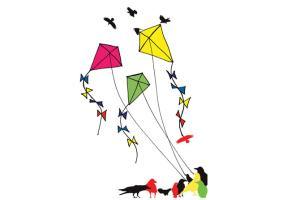
First installed at the Kala Ghoda festival in 2012, is a 15 feet 550 kg wonder, currently loaned to Vandana Talkies in Thane
 Paresh Churi is a Mahim-based landscape designer who graduated in statistics, but later studied plant and animal taxonomy. Recently, his illustration of Dichrostachys cinerea (thorny sickle bush) was chosen for display at Florilegium, Royal Botanical garden, UK. But, none of these varied interests define Churi, as much as his lifelong identification with crows. So intense is his love for the scavenger bird that his research papers have specially addressed three types of butterflies, which are called crows, two of which come on the window pane of his Ram Mandir building and surrounding green lanes of Mahim. "They are black in colour and I love watching them as I work from home. They remind me of the crows I followed while walking to the Balmohan Vidya Mandir School 30 years ago, when Mahim was a greener hospitable home to migratory birds."
Paresh Churi is a Mahim-based landscape designer who graduated in statistics, but later studied plant and animal taxonomy. Recently, his illustration of Dichrostachys cinerea (thorny sickle bush) was chosen for display at Florilegium, Royal Botanical garden, UK. But, none of these varied interests define Churi, as much as his lifelong identification with crows. So intense is his love for the scavenger bird that his research papers have specially addressed three types of butterflies, which are called crows, two of which come on the window pane of his Ram Mandir building and surrounding green lanes of Mahim. "They are black in colour and I love watching them as I work from home. They remind me of the crows I followed while walking to the Balmohan Vidya Mandir School 30 years ago, when Mahim was a greener hospitable home to migratory birds."
Churi, 41, passionately follows crows every day, clicks their photos in myriad moods, despite being the busy director of his landscape design company. His house allows free entry to all crows, not to forget the bolder ones, which eat ghee-soaked wicks in the silver diya. Often, they pick the diya and abandon it on the neighbour's balcony, from where it is routinely reinstated. He prides on live footage of crow movements, nesting and feeding behaviour and food storage techniques. He has noticed a tendency of crows to take free BEST bus rides. "I have seen them enjoying the top double decker ride; in fact, I wait at the Plaza cinema junction to see many of them alight vehicles to change routes," says Churi, who has also filmed armies of crows flying at breakneck speed from
Shivaji Park to Mahim, in pursuit of the Bhavnagari gathiyan offered by a feeder on Mahim beach. Churi has captured crows feasting on mithai during the pitru paksha, the fortnight when Hindus feed crows as a token of respect to departed ancestors.
ADVERTISEMENT
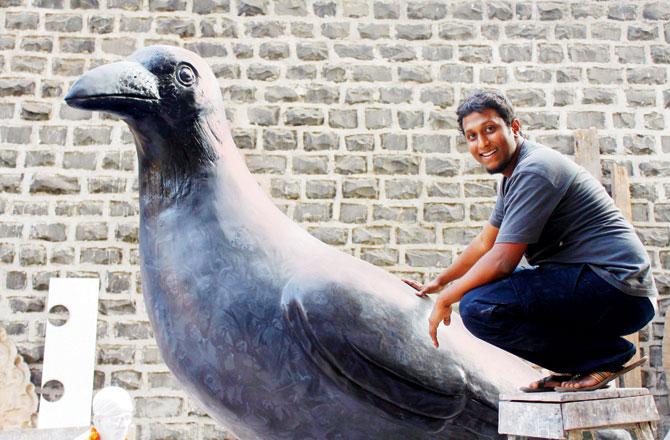
Artist Sumeet Patil's fibre crow
Like Churi, Sir JJ Institute of Applied Art alumnus Abhijeet Kalan, 37, is another hardcore crow fan. He admires crows for their supreme mental faculties, but doesn't believe in feeding them on special occasions. In fact, he feels crows are too intelligent to remain hungry in a city that produces tons of garbage every day. "I don't see ancestors in the crows, which many do. But I see them as exemplary adaptors-survivors who make do with whatever they get." Kalan, at one point, entertained a visitor crow who preferred freshly roasted poli, and did not touch the stale one. "Crows know how to push their case."
Out of deep respect for the crow, Kalan has taken on the Thousand Crow Project, in which he has so far etched 425 avatars. The first 100 crows emerged without any thematic focus; but, the recent 200 are part of a larger design which only his inner eye is aware of. He feels that 1,000 crows is a minimum required body of work, which will continue lifelong. His sanitiser crow, socially distanced crows and crows juxtaposed with the symbolic hourglass have become popular on social media. Kalan's blog Kakboli as well as Instagram handle @crownicles captures crows in random reflections, often in poetic metre. His haikus on crows flow in free verse, capturing the seeming ordinariness of crows. When his daughter was born, the naming ceremony invite depicted a crow family.
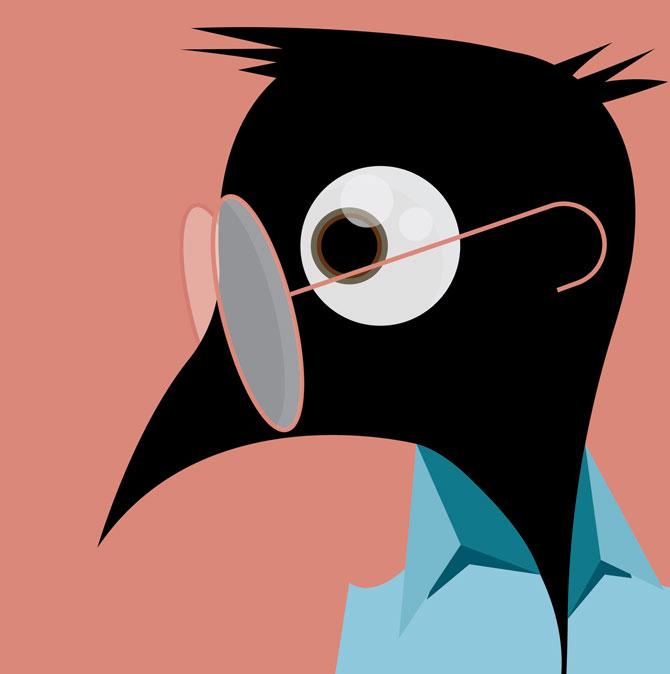
Abhijeet Kalan's Thousand Crow Project features crows in different avatars. His santiser crow is one of the many pandemic-themed creations
A believer in minimalism, Kalan also doesn't 'explain' his crow illustrations. "A crow, for me, is a sensibility. It is an oblique take on obvious realities." For instance, his "Pitru Paksha Special Terminal 3A Heaven To Earth" speaks of mass deaths; the crows on sale for pind daan depict the death rites industry in which crows play such a vital seasonal role.
Crows reside in Kalan's heart every moment, ever since he was called Kavla or Kaau in school. The Thane resident recalls his early crow-like behaviour (sharp observation and the habit of picking on people) for which he was called by the same nickname at his Sir JJ School days, when he was studying photography and other applied arts. Once he portrayed himself as a crow in an assignment on identity design. Later, when he opened his Facebook account, he again resorted to the crow. He says: "Crows are like common men and women, they are part of the good and bad of life. They are as mundane as tap water, and as metaphysical as the antarchakshu." Kalan says if reincarnation exists, he would prefer to be a crow.
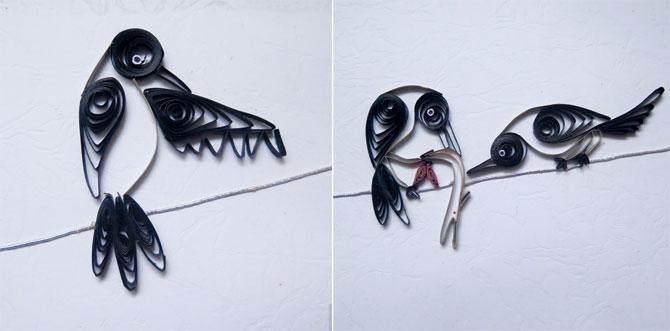
Landscape designer Paresh Churi's Mahim home is open to crows who often find representation in his art
Another artist Sumeet Patil, 30, is officially called Kavlya, and not just because he is dark-complexioned, but because he has literally honoured the crows in myriad ways. His much-feted documentary Intelligent Crow opens a cute world of the omnivorous, omnipresent, not-much-respected-but-shooed away raven. Patil feels the crow could have been India's national bird, had Indians acknowledged the black beauty's immense scavenging power. "They are free cleaners in cities like Mumbai. From the ticks on a cow's back to leftovers in any gathering, they eat almost anything and everything." Since 2004, Patil has been documenting crow life in still photos and video footage—be it a crow drinking from a leftover Fruity tetrapack, a crow playing with an eagle, a crow sucking sugarcane. In the feature film Ek Hota Kaau, in which Patil was the art director, around 100 crows were summoned during the shoot days. Patil's mastery over the caw caw signal received tremendous response from the neighbourhood crows that gathered on the sets. He received similar cooperation from crows in a calendar shoot in which he made celebrities pose with crows. His iconic fibre crow (first installed at the Kala Ghoda festival in 2012 and since then touring all over India) is a 15-feet 550 kg wonder, currently loaned to Vandana Talkies in Thane. Very often, Patil is approached by random people for selfies with his tallest crow creation.
Patil views crows as a neglected breed, even more so in the lockdown. He laments the crows which eat plastic and unhealthy garbage. Also, he makes a strong case for feeding crows in the ongoing pitru paksh. "The lockdown has robbed humanity of basic courtesies. So, if humans are feeding crows, even if it is for the sake of their own salvation, I welcome the idea." As part of his youth group Shreerang Charitable Trust, Patil has designed a limited edition pitru paksha T-Shirt series, which he declares the occasion as happy and endearing.
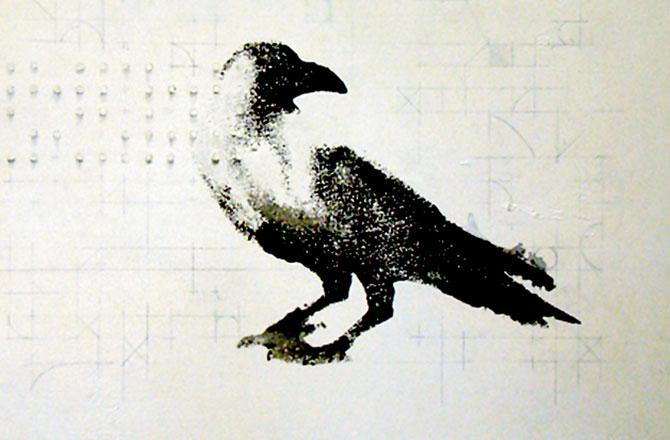 An Untitled crow creation by Somnath Mane, 2009
An Untitled crow creation by Somnath Mane, 2009
Another alumnus of Sir JJ Institute, Somnath Mane, 41, who once painted crows on the canteen wall (using the trademark charcoal powder), feels crows are the closest and the most effective metaphor for humans. In fact, his MFA course installation Crowshit depicted crows seated in a disciplined mudra on a white-coloured wooden platform. His doubled-edged work (Witness, 2009) at the Kala Ghoda festival connected the crow with his self portrait. Mane feels crows prompt humans to think about themselves. In fact, he believes that bygone students of JJ come back in the form of crows. "I have studied them on campus, they seem so invested in the art works."
Interestingly, crows are popularly associated with inauspicious themes; the zhoot bole kauwwa kaate line lives up to the dark negative public projection. No wonder they are not preferred as exhibits in Indian museums. Mumbai's iconic CSMVS museum, which showcases taxidermised animals and birds has only one black and one white crow exhibit. "In museum spaces, it is always the colourful parakeets and parrots which steal shelf space," says CSMVS assistant curator Manoj Chaudhari.
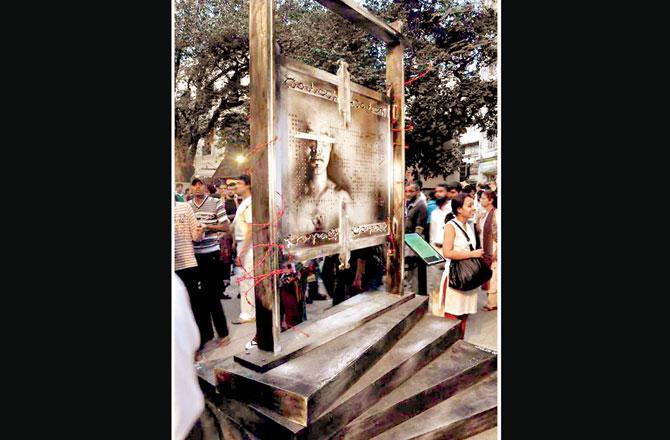
Mane's Witness at the Kala Ghoda festival connected the crow with his self-portrait
Either adored, fed or shooed away, crows inhabit the artists' consciousness. They get legitimate bhaaav, in Mumbai parlance, on religious occasions. Even COVID-19 has not been able to rob them of the due honours. However, in my kitchen balcony, crows are harbingers of chivda, bread crumbs, rotis, at one point a donut too. I don't like the mess they create; their pre-monsoon rush to steal loosened twigs from my kharata broom reminds me of nature's primal callings. I don't encourage crow movement in the interiors, also because I know that my non-believer atheist father wouldn't choose the pitru paksha for visiting me.
Sumedha Raikar-Mhatre is a culture columnist in search of the sub-text. You can reach her at sumedha.raikar@mid-day.com
Keep scrolling to read more news
Catch up on all the latest Mumbai news, crime news, current affairs, and a complete guide from food to things to do and events across Mumbai. Also download the new mid-day Android and iOS apps to get latest updates.
Mid-Day is now on Telegram. Click here to join our channel (@middayinfomedialtd) and stay updated with the latest news</p
 Subscribe today by clicking the link and stay updated with the latest news!" Click here!
Subscribe today by clicking the link and stay updated with the latest news!" Click here!







